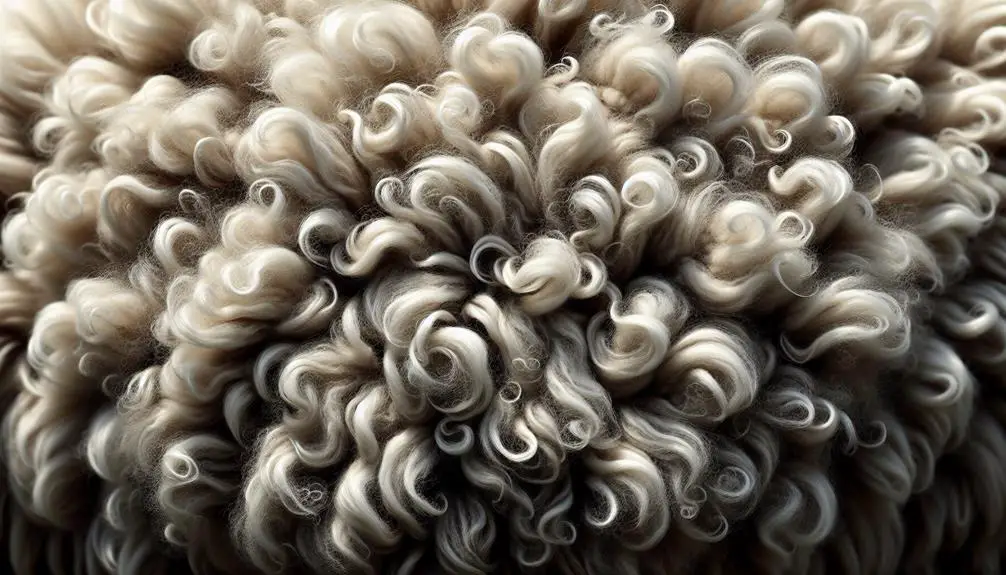Merino wool is the most common type of wool. It's loved for its luxurious feel, softness, and temperature regulation. If you want to learn more about various types of wool, keep exploring the unique properties each type offers.
Table of Contents
Key Takeaways
- Sheep wool is the most common type globally.
- Sheep breeds produce wool with diverse characteristics.
- Sheep wool is versatile for various products.
- Sheep wool's natural crimp, elasticity, and heat retention are beneficial.
- Sheep wool supports sustainable practices in the textile industry.
Merino Wool
Merino wool, with its luxurious feel and natural elasticity, is a highly coveted material in the world of high-quality clothing. Originating from the fine and soft fibers of Merino sheep, this wool stands out for its remarkable qualities. The wool from Merino sheep is incredibly soft, with fibers as fine as 17 microns, making it one of the most comfortable types of wool available.
What sets Merino wool apart is its exceptional temperature regulation capabilities. This wool is adept at keeping you warm in cold weather and cool in warm weather, making it a versatile choice for various garments. Additionally, Merino wool possesses excellent moisture-wicking properties, ensuring that you stay dry and comfortable throughout the day. Whether you're looking for a cozy sweater for winter or a breathable top for summer, Merino wool is a top choice due to its quality and performance.
Shetland Wool
Shetland wool, known for its softness and warmth, is a favorite among knitters and clothing designers alike. Traditional knitting patterns using Shetland wool often showcase intricate designs and timeless styles.
Its cozy feel and classic appeal make it a sought-after choice for those who appreciate quality craftsmanship in their garments.
Softness and Warmth
Known for its luxurious softness and exceptional warmth, Shetland wool sourced from Shetland sheep is a popular choice for cozy knitwear and outerwear.
This type of wool provides excellent insulation, ideal for cold weather garments. The fine, soft fibers of Shetland sheep come in natural colors, enhancing the wool's appeal.
The durability of Shetland wool, along with its slight fuzziness, adds to its cozy feel. Due to its exceptional softness and comfort, Shetland wool is commonly used in traditional Fair Isle knitwear.
When looking for a wool that offers both warmth and a soft touch, Shetland wool from these special sheep is a top contender for creating snug and stylish pieces.
Traditional Knitting Patterns
Delving into the world of traditional knitting patterns, particularly those suited for Shetland wool, reveals a rich tapestry of intricate colorwork and textured stitches that showcase the unique qualities of this renowned material.
Originating from the Shetland Isles, this wool's natural colors add depth to traditional designs. Its insulation properties make it perfect for crafting winter suits, providing both warmth and durability. While lacking natural stretch, Shetland wool compensates with its ability to keep the wearer cozy in colder climates.
Traditional Shetland wool patterns often incorporate historical motifs and patterns, reflecting the heritage of the region. Whether creating Fair Isle sweaters or cozy hats, working with Shetland wool allows knitters to connect with a long-standing tradition of craftsmanship and style.
Lambswool
Lambswool, sourced from the first shearing of young sheep, is renowned for its exceptional softness and fine texture. Here are some key facts about this luxurious wool:
- Softest Wool: Lambswool is considered the softest type of wool available, making it perfect for garments worn close to the skin due to its smooth and non-itchy nature.
- First Shearing: This wool comes from young sheep, known as lambs, making it particularly soft and fine compared to wool from older sheep.
- Luxurious Feel: Lambswool is highly sought after for its luxurious feel, which adds a touch of elegance to high-quality sweaters, scarves, and other apparel items.
- Ideal for Knitwear: Its exceptional elasticity provides a natural stretch, making it a popular choice for creating comfortable and well-fitting knitwear items that are cozy yet stylish.
Lambswool truly stands out for its unmatched softness, making it a top choice for those seeking both comfort and quality in their winter wardrobe.
Alpaca Wool
Sourced from the Alpaca in South America, Alpaca wool is renowned for its luxurious feel and natural hypoallergenic properties. Alpaca fibers, ranging from 15-40 microns in diameter, are highly prized in the textile industry. They are often blended with other types of wool to enhance their qualities. One remarkable feature of Alpaca wool is its hypoallergenic nature, making it an excellent choice for those with sensitive skin.
Here is a breakdown of Alpaca wool:
| Fact | Description |
|---|---|
| Origin | South America |
| Fiber Diameter | 15-40 microns |
| Hypoallergenic Properties | Naturally hypoallergenic, suitable for sensitive skin |
| Color Variety | Different breeds offer a wide array of natural colors in their wool |
| Blending | Alpaca fibers are commonly blended with other types of wool for versatility |
Alpaca wool's combination of softness, warmth, and hypoallergenic properties makes it a popular choice for high-quality garments and textiles.
Cashmere Wool
Cashmere wool, renowned for its luxurious softness and warmth, is collected from cashmere and pashmina goats. Here are some key points about cashmere wool:
- Baby Cashmere: Younger goats produce baby cashmere, which is finer and more delicate than regular cashmere, adding to its exclusivity and softness.
- Quality Comparison: Cashmere wool is comparable to ultrafine merino wool regarding quality and insulation properties, highlighting its premium nature.
- Grades A-C: It's divided into grades A-C, with Grade A being the finest and most sought after for premium products, indicating varying levels of softness and quality.
- Water-Repellent: Cashmere wool is highly water-repellent and thermally insulating, making it an ideal choice for high-end apparel and accessories that require both luxury and functionality.
These characteristics make cashmere wool a sought-after material for those looking for both comfort and style in their garments.
Mohair Wool
I'll start by shedding light on Mohair Wool, originating from Angora goats and famous for its strong and lustrous fibers.
With staples ranging from 4-6 inches, this type of wool offers less tangling and shrinkage than other varieties.
Let's explore the unique characteristics and versatile uses of Mohair wool in the textile industry.
Mohair Wool Origins
Originating from the Angora goat, mohair wool is renowned for its long, lustrous fibers with a diameter ranging from 25 to 40 microns. Here are some key points about the origins of mohair wool:
- Angora goats, primarily found in Turkey, the United States, South Africa, and Australia, are raised for their luxurious mohair wool.
- Mohair wool is stronger than sheep's wool, offering durability and resistance to tangling and shrinkage, perfect for long-lasting garments.
- The length of mohair fibers varies from 4 to 6 inches, enhancing the fabric's smoothness and drape.
- The unique properties of mohair wool were famously showcased when Kurt Cobain wore a mohair blend cardigan, highlighting its versatility in fashion.
Mohair Wool Characteristics
What sets Mohair wool apart from traditional wool fibers in terms of strength and durability? Mohair wool, sourced from Angora goats, boasts stronger fibers ranging from 25-40 microns in diameter, making it more robust than regular wool. Its long staples of 4-6 inches contribute to its resilience, as Mohair wool is less prone to tangling and shrinkage compared to other types of wool. To illustrate these characteristics clearly, let's take a look at the table below:
| Mohair Wool Characteristics | |
|---|---|
| Fiber Diameter | Stronger fibers (25-40 microns) |
| Staple Length | Long staples (4-6 inches) |
| Tendency to Tangle | Less prone to tangling |
These unique properties make Mohair wool a premium choice for various applications due to its durability and strength.
Mohair Wool Uses
Exploring the diverse applications of Mohair wool reveals its versatility and lasting appeal in various industries. Mohair wool, sourced from Angora goats, is prized for its strength, durability, and unique qualities.
Here are four common uses of Mohair wool:
- Fashion Industry: Mohair wool's long staples and luxurious texture make it a popular choice for high-end fashion garments.
- Home Textiles: Its durability and resistance to wrinkling make Mohair wool ideal for upholstery, rugs, and drapes.
- Outdoor Gear: Due to its moisture-wicking properties and strength, Mohair wool is used in outdoor clothing like socks and sweaters.
- Crafts and Art: Artists and craftspeople often utilize Mohair wool for its lustrous appearance and ease of dyeing.
Angora Wool
Combing Angora rabbits regularly yields the exceptionally fine and fluffy Angora wool from their soft undercoat. The fine fibers of Angora wool, ranging from 10-15 microns in diameter, are a result of the careful breeding and handling of Angora rabbits. Due to its delicate nature, Angora wool is often blended with stronger materials to enhance durability. The production process involves gently combing the rabbits to collect the soft undercoat fibers, ensuring the animals' well-being is a top priority. However, ethical concerns have arisen regarding the treatment of Angora rabbits in some farming practices, highlighting the need for responsible sourcing of this luxurious material.
| Key Points | Details |
|---|---|
| Origin | Soft undercoat of Angora rabbits |
| Fiber Diameter | Exceptionally fine, 10-15 microns |
| Production Process | Regular combing of rabbits to collect soft fibers |
| Ethical Concerns | Issues surrounding treatment of Angora rabbits in some farming methods |
Vicuña Wool
Vicuña wool, sourced from the rare and protected vicuña species indigenous to the Andes mountains in South America, is renowned for its exceptional softness and luxurious quality. Here are some key facts about this remarkable wool:
- Rare Origin: Vicuña wool is derived from the vicuña, a species that roams the Andes mountains and is protected due to its endangered status.
- Unmatched Softness: Considered one of the softest natural fibers globally, vicuña wool boasts a luxurious feel that's unparalleled.
- Fine Fibers: The fibers of vicuña wool are incredibly fine, measuring between 12-14 microns in diameter, contributing to its exquisite texture.
- Insulating Properties: Known for its exceptional insulating properties, vicuña wool provides warmth without the bulk, making it a preferred choice for high-end luxury garments.
With its rarity, softness, and insulating capabilities, vicuña wool stands out as a premium material sought after by those who value both quality and exclusivity.
Camel Wool
I love the cozy warmth of camel wool and how it adds a touch of luxury to any garment.
The natural golden brown shade of camel wool is truly unique, making it stand out from other types of wool.
Blending camel wool with other fibers not only enhances its softness but also contributes to its sustainability.
Benefits of Camel Wool
With its luxurious warmth and excellent insulation against cold weather, camel wool stands out for its natural golden brown shade, adding a distinctive flair to garments and accessories.
Here are some benefits of camel wool:
- Natural Insulation: Camel wool offers exceptional insulation properties, keeping you warm in chilly conditions.
- Softness: The natural crimp and softness of camel wool make it comfortable to wear against the skin.
- Blended Fibers: Often blended with other materials, camel wool maintains its insulating abilities while enhancing softness.
- High-End Fashion: Popular in high-end fashion, camel wool is used in coats and apparel, providing a stylish and sophisticated look.
Sustainability of Camel Wool
Camel wool, known for its sustainability and environmental benefits, has gained recognition for its unique properties in the textile industry. Sourced from camels that thrive in harsh desert environments with minimal resources, camel wool is a sustainable choice.
Compared to traditional wool sources, such as sheep, camel wool production requires less water and feed. Additionally, camels naturally shed their wool, eliminating the need for shearing and reducing animal stress. This biodegradable fiber not only benefits the environment but also supports local economies in regions where camels are raised.
Sheep Wool
Sheep wool remains the most predominant type of wool utilized in the textile industry due to its exceptional softness and durability. As a sustainable resource, sheep wool is sourced from the fleece of sheep, offering a renewable option for various products.
- Versatility: Sheep wool is incredibly versatile and finds application in a wide range of products, including clothing and home textiles, showcasing its adaptability in various industries.
- Breeds Produce: Different breeds of sheep produce wool with distinctive characteristics, such as fineness and strength, allowing for a diverse range of wool types to cater to specific needs.
- Wool Fibres: The wool fibres from sheep are known for their natural crimp, elasticity, and ability to retain heat, making them ideal for creating warm and comfortable textiles.
- Wool Production: Sheep wool is a vital component of the textile production chain, with its shearing process contributing to the creation of high-quality wool products while supporting sustainable practices.
Frequently Asked Questions
What Are the Three Main Types of Wool?
Sure, the three main types of wool are Merino wool, Cashmere wool, and Mohair wool. They each have distinct qualities and origins. Merino wool is fine and drapes well. Cashmere comes from goats and is very fine. Mohair is strong and slightly more expensive.
What Is the Most Common Source of Wool?
Sheep are the primary source of wool globally. Their wool is valued for its softness, durability, and versatility. Different breeds yield varying qualities of wool, like Merino known for its fine texture. Wool from sheep is sustainable and widely used in textiles.
What Is the Best Wool Called?
The best wool, known as Merino wool, stands out for its exceptional softness, fine texture, and luxurious feel. It's highly prized for its temperature regulation, moisture-wicking properties, and comfort against the skin, making it a top choice for premium clothing and outdoor gear.
What Is the Most Sought After Wool?
Merino wool stands out as the most sought after due to its fine fibers, luxurious feel, and versatile properties. Its natural elasticity, temperature control, and moisture-wicking features make it highly valued in fashion and outdoor gear.
- How Does Ring Spun Cotton Affect Garment Fit and Shape Retention? - August 13, 2024
- What Are the Challenges in Producing Ring Spun Cotton? - August 13, 2024
- Is Ring Spun Cotton Suitable for Plus-Size Clothing? - August 13, 2024







